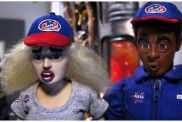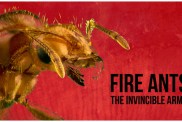Some might remember earlier this year when ComingSoon.net talked to a couple of the filmmakers behind the Oscar-nominated animated and live action shorts, and others might be aware that neither of our favorites won in their respective categories. Around the same time, we were offered an interview with Megan (Lost Boys of Sudan) Mylan, director of one of the four Oscar-nominated doc shorts “Smile Pinki.” Instead of potentially jinxing another one, we decided to hold off, and sure enough, “Smile Pinki” won!
For the short film, which will be airing on HBO starting on June 3, Mylan took her crew to India to follow two poor Indian kids with disfiguring cleft palates who, through the graces of the non-profit organization The Smile Train were able to get free operations to have their clefts fixed, so they had a better chance of having normal lives, rather than being ostracized by their communities. You might not think that a movie about children in India with clefts would be of interest, but it’s actually a touching and heartwarming tale mainly due to Mylan’s amazing star Pinki, a 9-year-girl who has so much charm and spirit despite having a condition that would normally prevent her from having happiness. Besides winning over the Academy and other audiences who saw it, the win by “Smile Pinki” was greatly celebrated in India along with the many Oscars won by Danny Boyle’s Slumdog Millionaire earlier this year.
With the Oscar already under her belt, ComingSoon.net figured it was safe to talk to Mylan about her short film, as well as the next feature-length doc she’s currently making down in Brazil.
ComingSoon.net: I’ve seen the movie a few times, but the first time was when MOMA presented the four Oscar nominations in the documentary short category, and yours followed another one set in India, “The Final Inch.”
Megan Mylan: Yeah, I mean, public health issues in India and then they’re both in Uttar Pradesh, in the same region. It also is the state with the worst health indicators in India, but it’s not surprising that that would be the place, but it’s amazing how that happens with like the two Capotes (also). You think you’re doing something unique and then all of a sudden…
CS: Did you get to meet the other filmmakers?
Mylan: Irene Brodsky, I didn’t know her ahead of time, but it’s been fun to connect with her. She used to live in New York and now lives in Portland, Oregon and I was raised in Oregon and now live in New York, so we have some common overlap. And my mother’s name is Irene so the list just goes on and on. (Laughs) So it’s just very nice. Documentary filmmakers, I almost always tend to like them. We usually have a lot of good feelings together a good group of people.
CS: Making docs is such a gamble because you’re going into this not knowing whether you’re going to have anything and what’s going to come out of it.
Mylan: Especially with verité when there’s really no scripting to be done.
CS: How did you first get involved with Dr. Singh and the Smile Train? Did they come to you?
Mylan: They actually did, which is not the way I’ve ever gotten into my projects in the past. To be quite honest, I sort of set the email to the side ’cause you get documentary ideas every day. Some of which are great and just for whatever reason you can’t move on them. They followed up again and really sort of caught my attention with the way that they do what they do, the fact that they don’t focus on sending American doctors abroad, that they’ve seen a problem that’s so simply cured and recognized, that there’s all of these doctors totally capable of doing this around the world and that they can just support them. Probably like lots of folks, I’ve seen the photographs of children with clefts in the newspapers Sunday morning and such and such and that was on my list of, “Oh, that’s too bad.” It never really went further than that and I think that’s always the case with documentarians, then you start learning more. I came to realize that clefts are one of the most common birth defects in the world and that they’re completely curable. There’s absolutely no reason a child has to live with this. Of course there are lots of issues like that, but they’re very often much more cumbersome problems to solve. I sort of got intrigued once I realized how prevalent this was and how smart and efficient the “Smile Train” is. I have a background in working in international development, so I have a pretty high bar for what I think is an appropriate model of ways that Americans can be effective. It’s been written up by “The New York Times” in the economics column as the most efficient non-profits around. So anyway, that’s what got me in. As a documentarian who does social issue films, there are lots of issues that I’m concerned about that don’t necessarily make for good stories. The issue might be what peaks my interest, but then the challenge is, “Is there a good story here?” Also, a good story that I can tell well ’cause I really like to only make films in verite usually with very strong, individual characters. Luckily, this story also did that where these kids are going through these once in a lifetime experiences and there was such a nice, natural journey structure to it that lends itself to verite really well.
CS: Was the idea just to follow Dr. Singh around and see who he meets?
Mylan: Yeah, so Dr. Singh is the surgeon and then Pankaji is the social worker. They do look a little bit alike and they actually both have the same surname, but they’re not related. I think easily the film could’ve been told from either one of their points of view, but I guess my method is usually, “Who’s going through the once in a lifetime experience? The children.” That was a big challenge, to find the kids and be there shooting at that key moment where for the first time they and their parents are finding out that this birth defect that they thought they would live with the rest of their lives, that would define the rest of their lives, can be simply and quickly cured for free. I had to be there shooting at that moment, but even though there’re a million children in India with clefts, there are many, many, many millions of people. I hope you come away from the film seeing that even though the surgery is quite simple and can be done very quickly, the work of finding the families and then convincing them is the bigger challenge, because these are folks, some of them who have really never been offered anything for free. They’re distrustful and they didn’t understand this was ever something that could be fixed. In a lot of instances, they thought that it’s a curse from God or punishment for having done something wrong, with some exceptions of the whole thing.

CS: When you were following him around, did you just come up to one kid’s story and say, “Okay, this is the one I should follow?
Mylan: Yeah, so you have to do a lot of the pre-production stuff. Unfortunately, I just couldn’t afford to follow him out for days on end with a crew. What I did was a little bit of a reconnaissance, I sent Nandini, my film producer in India, she went out with one of the other social workers and spent days out with them under the guise of being generic public health researchers. They met lots of kids who had clefts, but they also met children who had other issues. They went to the villages, they didn’t say what they were there specifically, then they got me about a dozen different children with a photograph of them and their families, just a little description of their storyline, their family situation. They didn’t talk to them specifically about the cleft or that it could be cured or anything like that.
It’s a little tricky. I hope it wasn’t terribly deceptive. Of course, they went back and gave all those children who we didn’t select their information. But what did allow me then with Pankaji, the social worker we do follow in the film, he knew that we were taking him to an area where there was a child we wanted to film with. We didn’t tell him how to get there, we just said, “Okay, here you go, do what you’d normally do,” and he found her in the natural way. When we were at the school, he really didn’t know that they were going to say, “There’s a little girl down the road, Pinki.” I don’t stage things because I’m sort of an orthodox verité filmmaker, but also because it never works very well. (laughs) I just always think it never passes the smell test. Things that happen naturally are just so much more interesting. That was our strategy where we knew where some of these children were and then just let him out there and do his pamphleteering and talking to taxi drivers and rickshaw drivers and going into the schools. When Nandini had sent me the dozen or so children, both Pinki and Ghutaru, the young boy that we follow in the film, really sort of jumped out at me. With Pinki, there was just a sparkle in her eye that was so unique and she just seemed so beautiful already. I thought, “How can this little child be ostracized? How can she be somebody who’s ridiculed so much that she can’t go to school?” She just seemed so charming, so if you’re making a character-driven film and your characters fall flat, you’re in really, really bad shape. As soon as I started shooting with both of them I was like, “Phew, we got it!” I just thought they both had something really special, not just the children, but each of their relationships with their parents I really appreciated. Like Pinki and her father had such a deep bond. He was so nurturing to her. Ghutaru, the little boy’s mother, I felt like was such a strong advocate and wasn’t going to be told that this is what she needs to do. Someone needed to prove to her that this was the right thing. Hardship or not, this is her son and she wants to keep him safe.
CS: One thing I’m surprised about, because there really are so many cases of this, is that the cases are so detached that they don’t realize how many other people have a cleft and there’s a cure for it. With so many cases, you’d think it would be common enough that they wouldn’t have been so surprised when they showed up at the hospital and saw so many others with it.
Mylan: I love the scenes where you just see someone who’s been treated as so different all of their life all of a sudden recognizing that, “Oh, I’m not the only one.” That’s why we have support groups, and they don’t have that. As common as it is, it’s a million children, but what is the population of India, it’s a billion, right? They live in a quite remote (area) and that’s part of the reason that it takes so much work to get the word out. In many cases, the families are illiterate. Pinki lives in a village that has no electricity whatsoever. She or her father had never been to Varanasin, the city where the hospital is, even though it’s not a long journey.
CS: They were somewhat hesitant about having the operation, but how about having someone filming them the whole time
Mylan: I don’t know if I just get lucky or if it’s something that I do. For this film, we actually met the families while shooting which is something I never do. Normally, I really try and take some time to meet people without any equipment and sit and talk with them about what my motivations for telling this story is, what it will involve for them, obviously recognizing that nobody ever really gets what it’s gonna mean to have a camera with you 20 hours a day sometimes. In this case, we filmed the initial scene with Pankaji the social worker meeting these families, but after that, then I did stop and reach out with his and my field producer’s help to explain to the families that now their child was going to go on this journey to be relieved of this affliction and that we wanted to get the word out as widely as we could as soon as possible. So if their families would share their stories it would help many, many other families. I think that it’s just a lotta eye contact too and being respectful and I always say, “When you want us to stop filming just say the word.” I think when you give people that sense of control, they very rarely ask for it. I also tend to tell stories that aren’t really trying to get to something that somebody is trying to hide, they’re very much slice of life stories. So, there’s plenty in any one day to be revealing and I feel like I don’t have to shoot at moments that might make them uncomfortable. Also, when you’re going through a really intense experience, your priority is not the camera.

CS: How do you remain transparent in cases like this, because obviously camera crews aren’t seen all the time in those areas? What was the size of the crew, just two or three of you?
Mylan: I work with a really small crew to try and as much as possible make us not the story. I do sound myself, so often I work with a two-person crew. On this one, we were a three-person crew; it was me, and a camera person and our field producer who served as a translator. You just try and be really respectful. I find that you can just have a conversation early in the day and then you just follow and if anyone says no, then you really respect that and don’t push them. Especially filming with children, there will always be a lot of interest. I think high schools are like the worst place to shoot verité. I wish somebody would give immediate training to kids that if you want to show up in a documentary, don’t jump in front of the camera. That’s the best way not to show up in the film. Even in a village that had never seen, we being white foreigners, we stood out and of course with all of our gear we stood out. After a while, people go on about their business. It was a big deal that Pankaji, the social worker was there visiting as well and when he started saying that Pinki and Ghutaru could have the surgery, that became more interesting than us.
CS: I like your idea for a class “How to be in a Documentary.”
Mylan: (Laughs) We’re constantly going, “Pretend we’re not here,” which of course is a hopeless line. Then there’s always people you have to cut around. At times, because you don’t have to shoot 24/7, there would be times when I’d let the kids listen in on my headphones and we’d show them how the camera works and stuff like that when we were done, you sort of demystify it. It’s amazing to me how after a while, some people start out very comfortable, others never get over it. Most people forget after a little bit ’cause you just eventually have to go about your…
CS: Every documentary filmmaker I’ve talked to says that, but I just can’t even imagine having to do that.
Mylan: I can’t imagine it. I think it sounds torturous to be the subject of a documentary, especially that my life would make for such a boring film. But, I do think you do. I work with really great craft people who also have sort of a quite presence and I think that’s really helpful, too. I think that there are people who, even though they try, they just can’t help but sort of call attention to themselves. Nick Doob and Jon Shenk are the two camera people I work with and they have a way of sort of being there without drawing attention to themselves.
CS: Did you always know this was going to be a short film?
Mylan: No, I started out thinking that it would be anywhere between 30 and 60. I hoped that this would have a television broadcast and theatrical settings. My last film “Lost Boys of Sudan” was feature length, and then after it had theatrical and TV, we did two years’ worth of community venue screenings that were really rich, 300 public libraries and I went on the university circuit. But 90 minutes is long for organizing discussion rounds, you’re asking for a big chunk of somebody’s Thursday evening. So I always thought that on one level of just getting the film out there to groups who would enjoy using it that shorter would be better. Then it was just a decision of how many storylines to include and when I decided to focus primarily on Pinki with Ghutaru as sort of a second character, this is the length it needed to be. It’s a journey story and in some ways it’s a very simple story think. I hope that there’s a lot of nuance in there and it makes you think and feel all sorts of different things. But, on this plot, it’s a little girl with a cleft, someone comes to her village and tells her it can be fixed and you go along the road with her and her dad until it is. I think it ended up at the length it needed to be. We actually had a third character and we dropped that storyline out and we ended up at 43 minutes first draft of that, so it was very close to where it is now.
CS: Now that we’ve seen the results of these two kids and what happens with their operation, what has been going on with them since your started screening and then won the Oscar?
Mylan: Well, that’s one of the wonderful things. I always hope that the film will have a positive impact on the character’s life first and then a larger ripple positive effect after that. You can’t ever really guarantee it. I of course could guarantee that I would give Pinki and her money family, but I didn’t need to do that. They were getting their rewards from the surgery. Happily, some really wonderful things have happened for both of the main two children in the film. Pinki of course, was able to come to the Oscars with us. She and her father and Dr. Singh, the surgeon, all came with us. So she’s turned into a little mini-celebrity in India, which is really crazy. This film has been embraced. Every time “Slumdog” was mentioned, they mentioned “Smile Pinki” too, not in this country, but there. When she got back, there was a heroes welcome. They went and met the Prime Minister’s wife on the Senate floor. You know, “Congratulations to ‘Slumdog Millionaire’ and ‘Smile Pinki’ for the Oscars.” I got a letter from the Prime Minister. It’s just pretty crazy and wonderful. Even though I’m a foreign filmmaker, it’s very much been embraced as an Indian story. But there’s some really great concrete things that have happened for Pinki. She’s been offered a scholarship, both she and Ghutaru, to schools a little bit outside of their village that are a little bit better. In Pinki’s village, the district government came in and made them a model village and put on new corrugated roofs, built some new housing that can withstand the monsoon, put in automated water pumps for fresh water, are working on the roads again and talking of bringing electricity. Both the kids have the scholarship and great things have happened for her from the village. I made the film about Sudanese refugees and both of these men ended up with full ride scholarships as a result, which is great. You never know that’s gonna happen. Then on top of it, we raised a million dollars for scholarship funds for other refugees, so it’s like the first stage is making a good movie and then if it stirs up some energy that makes people want to do something and you can capture that and put it to work, all the better.

CS: What about the Smile Train though?
Mylan: Yeah, I mean I don’t think it’s every organization. It’s actually really wonderful that with this film that it’s such a clear way people can get involved and that it’s such a simple surgery that every donation, it’s $250 to do a surgery of a child and it changes their life forever. It’s incredible how quickly it happens and how simply it can happen. So definitely I hope that people who see the film want to support their work and more generally we’re working to use the film, especially in India and China, to build awareness amongst potential patients, to really get the film out into village settings, school settings, to let people know that this nothing any child needs to live with.
CS: Have you started working on another movie? I know that you’ve been doing a lot of promotion for this over the last few months.
Mylan: Yeah, every time you get into a film, you have to tell yourself to be careful because it’s going to be a multi-year relationship and a piece of your heart forever. I have. I’ve actually started shooting a film on race relations in Brazil. It’s been really interesting. I’ve actually started shooting that one before this one, so it’s feature length and it’s a longer trajectory that we’re watching. They as a country, they’re sort of grappling with this multi-racial identity that they have and I’m looking at sort of the reality of that. I’m directing, but I’m the only American. I’m working with an all Brazilian crew and happily they’re all Rio based so that’s where I get to go for editing. It’s a rich country and there’s an endless number of stories.
CS: So are you filming that in a similar way, just following certain people around?
Mylan: We have three main characters and their stories are interwoven. They’re all people who are in these transformative moments in their own lives but are also exemplary of the shift that’s happening around race issues. One guy is a Senator that’s just written the affirmative action legislature that’s gone into place and is now being challenged. Another woman is the granddaughter of slaves and she lives on what they call “quilombos”–they’re like Maroon societies that were established by runaway slaves that lay in the interior of the country. The current President Lula, when he came into office, gave them land rights sort of like Native American reservations, but now the big agri-business is trying to push them off of that land so we follow her attempt to stay on her ancestral land. The third character is an entrepreneur in São Paulo who started a TV station with the idea that it has the face of Brazil in front of and behind the camera. TV tends to be pretty white down there. Hopefully, it will all come together so we’re sort of in the weaving the stories together phase right now.
CS: Maybe we’ll see it at a festival soon, that’s great. Listen, thanks a lot, I really appreciate you taking the time to talk.
Mylan: Thank you for seeing the movie a couple times.
CS: Yeah, it was great. I have to be honest, when I filled out my Oscar ballot, I just assumed that the Martin Luther King doc would win.
Mylan: You know, we sort of did, too. I mean, how can you vote against Martin Luther King? Also with Obama, there’s so much reflection on the Civil Rights Movement and stuff. But they’re all good. This is wonderful to have this award, but we had already won just getting nominated. The attention that comes along with the Oscars is really special and if more people see this film I think the better the world might be.
CS: I think your movie did get the best crowd reaction at the MOMA screening; people were just gushing and crying.
Mylan: I was talking to people when I was working on the film and I’d say, “Oh, I’m working on a documentary about children with clefts.” You could just see people’s eyes just go, “Huh?” I think it’s a story about a lot of things. I think clefts are very important. Very often I think it’s a portrait of a father and daughter and just a hopeful story. For me, it was wonderful to be able to work on something that can be emotionally moving and it didn’t necessarily have to be dark; it can be hopeful. It’s good to have the freedom to just do it as I wanted.
Megan Mylan’s Oscar winning “Smile Pinki” premieres on HBO on Wednesday June 3 at 7 PM, and then reruns on HBO and HBO2 at various times over the course of the month. You can watch the trailer below.









